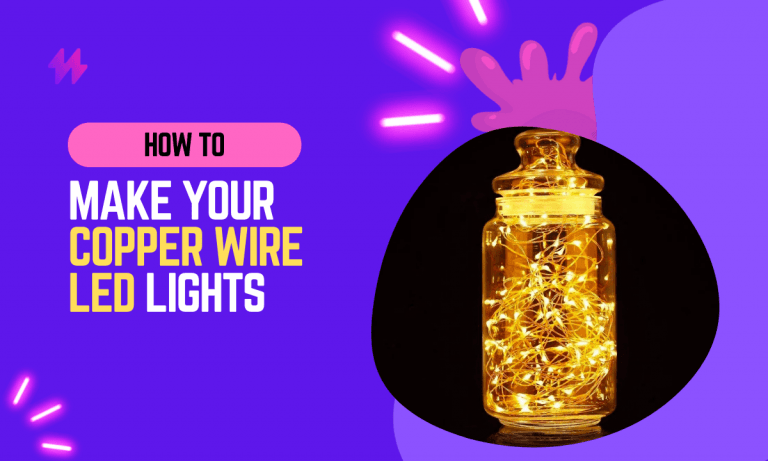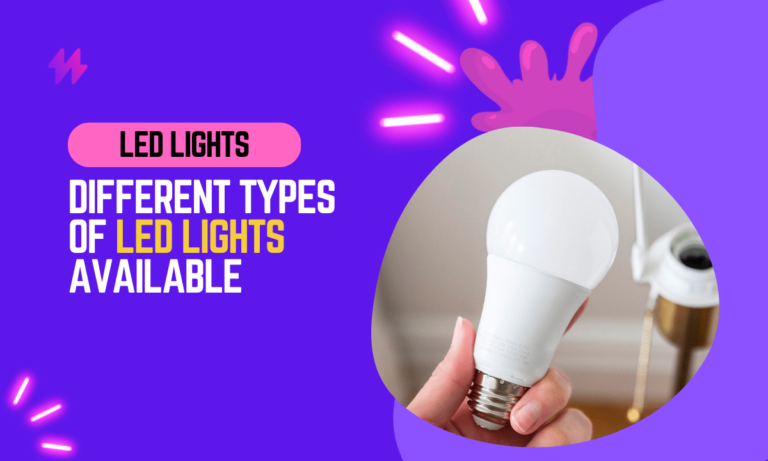How to Manufacture LED Lights?
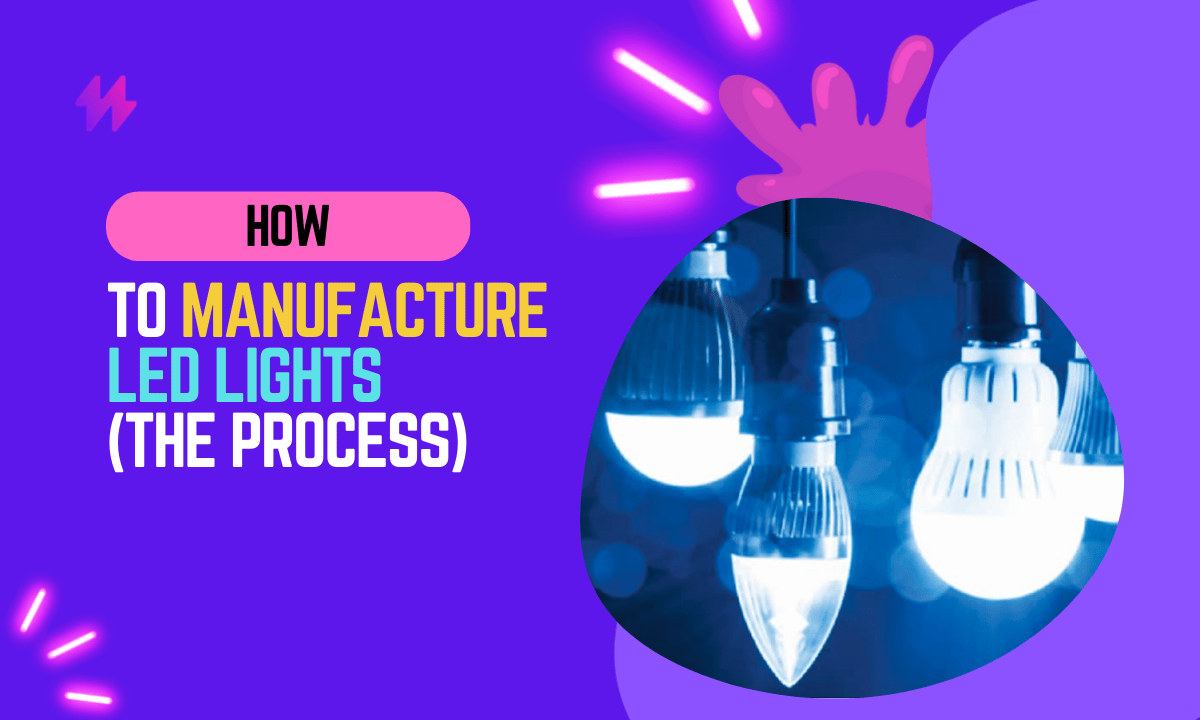
LED lights have revolutionized the world of lighting, offering energy efficiency, longevity, and versatility in a variety of applications. Whether it’s in our homes, offices, or even outdoor spaces, LED lights have become an integral part of modern lighting solutions. But have you ever wondered how to manufacture LED lights?
Throughout this LED lighting guide, we will explore various aspects of LED light manufacturing, including the production of LED chips, the assembly of components, quality control measures, and the packaging and distribution process.
Let’s shed some light on how these extraordinary devices are made.
LED lights production involves a complex process that starts with the creation of light-emitting diodes (LEDs) and extends all the way to assembling finished light fixtures ready for market distribution. The efficiency of led bulb manufacturing also hinges on advanced manufacturing techniques and machinery that ensure quality lighting suitable for various applications, from commercial uses to residential needs. Moreover, an adept led lighting manufacturer focuses on delivering reliable products to meet modern lighting industry demands. With the continuous evolution in technology, led fixtures have become essential components for both innovative electronics and traditional light bulbs, illustrating the growing importance of efficient LEDs in everyday life.
Understanding the Basic Components of LEDs: How to Manufacture LED Lights and How LED Light Works | LED Bulb Manufacturing Insights from an LED Bulb Manufacturer
LEDs consist of several basic components that work in harmony to produce light efficiently and effectively. Understanding these components is essential to grasp the fundamental workings of an LED and its manufacturing process.
The components of LEDs, or light-emitting diodes, include a semiconductor material that emits light when an electrical current passes through it. Understanding how these elements interact is crucial for the LED production process, as it informs decisions pertaining to the manufacturing plant’s efficiency and the overall quality lighting of the final products, including various led bulbs and light fixtures.
Essential Elements: Understanding the Semiconductor Chip in LED Manufacturing
At the heart of an LED lies a semiconductor chip, usually made of materials such as gallium nitride (GaN) or gallium arsenide phosphide (GaAsP). The chip is responsible for generating light when an electric current passes through it. The specific composition of the semiconductor determines the color of the emitted light.
The production of light-emitting diodes (LEDs) is a highly specialized field that requires precision and expertise in the manufacturing process. A reliable LED lighting manufacturer ensures that all electrical components are carefully chosen and tested to produce high-quality lighting products for various applications, including streetlights and commercial lighting applications. In the pursuit of efficient LEDs, manufacturers constantly explore innovative technology to enhance the lighting quality and performance of their fixtures. Understanding the nuances of LED bulb manufacturing allows for the creation of robust lighting fixtures that can outperform traditional incandescent bulbs.
Substrate: Understanding Its Role in LED Manufacturing
The substrate acts as a support for the semiconductor chip. It is typically made of materials like sapphire or silicon carbide, providing stability and durability to the LED.
In the intricate process of LED lights production, the careful selection of substrates such as sapphire or silicon carbide is pivotal for ensuring the stability and durability of the semiconductor chip. An efficient LED lighting manufacturer recognizes that understanding the interplay between these electrical components and the manufacturing procedure is essential for producing robust lighting fixtures that can effectively compete with traditional incandescent light bulbs.
Essential Components of LED Lights: Understanding Contacts
LEDs have two electrical contacts—an anode and a cathode. The anode, usually the longer lead or the positive terminal, connects to the p-type (+) region of the semiconductor. The cathode, typically the shorter lead or the negative terminal, connects to the n-type (-) region of the semiconductor.
In the realm of electronics, the transition from traditional incandescent bulbs to light-emitting diodes (LEDs) signifies a pivotal shift towards energy efficiency and longer-lasting products. Furthermore, reliable light sources like LED fixtures and lamps have become integral to modern lighting controls, proving their superiority in both commercial lighting applications and everyday usage.
Encapsulation: Understanding the Key Components of LED Lights
To protect the delicate semiconductor chip and enhance the efficiency of light emission, LEDs are encapsulated within a transparent or translucent material. This encapsulation material can be an epoxy resin or a silicone-based compound. It helps to focus and direct the emitted light, ensuring optimal brightness and distribution.
Encapsulation not only offers protection for the semiconductor chip but also plays a vital role in optimizing the light emission of LEDs. This crucial aspect of the led manufacturing procedure contributes significantly to the overall lighting quality and performance of products such as led lamps, fixtures, and displays, solidifying their place in the lighting industry.
Reflective Cavity in LED Lights: Understanding Its Importance in Manufacturing
Some LEDs incorporate a reflective cavity or a cup-like structure behind the semiconductor chip. This cavity helps redirect the emitted light toward the desired direction, increasing the overall efficiency of the LED.
Efficient light-emitting diodes (LEDs) have successfully transformed the lighting industry, enabling a wide range of applications from streetlights to modern LED displays. With the growing emphasis on energy efficiency, bulb manufacturers are increasingly focusing on enhancing the quality and performance of their lighting products to meet diverse lighting needs.
Understanding Wire Bonds: Key Elements of LED Lighting Components
Wire bonds are used to establish electrical connections between the contacts of the LED and the semiconductor chip. Typically, thin gold or aluminum wires are bonded to the contacts, ensuring a reliable electrical connection.
Must read: Different Types of LED Strip Lights and Their Features
Wire bonds are used to establish electrical connections between the contacts of the light-emitting diode (LED) and the semiconductor chip. Typically, thin gold or aluminum wires are bonded to the contacts, ensuring a reliable electrical connection that enhances the efficiency of the overall led bulb manufacturing process. This critical aspect of LED production highlights the importance of quality materials and advanced manufacturing techniques employed by a good manufacturer to create high-performance LED products.
LED Lights Manufacturing Process: Key Steps in How They Are Created
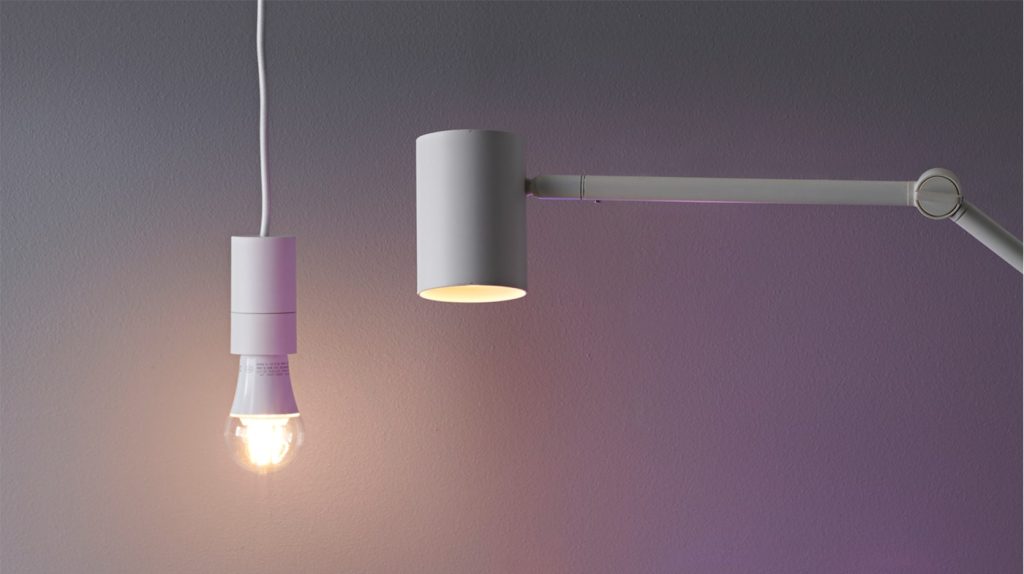
Pre-Production Phase: Key Steps in LED Lights Manufacturing Process
Before the manufacturing of LED lights can commence, a crucial pre-production phase takes place, encompassing essential tasks that lay the foundation for a successful production process. This phase involves research and development, designing the LED lights, and carefully selecting the necessary components and materials.
In the pre-production phase of LED lights manufacturing, meticulous attention is given to designing the components and configuring the power supply requirements necessary for effective functionality. This early stage is essential as it establishes the groundwork for producing reliable light fixtures that can cater to both commercial and residential demands, significantly impacting the overall efficiency of the production flow. Today’s competitive market for LEDs emphasizes the importance of selecting innovative technology and efficient materials to create finished light fixtures that outperform traditional incandescent light bulbs. Furthermore, understanding the nuances of electrical devices and their interactions with circuitry is vital for any reliable manufacturer in the LED bulb manufacturing industry.
Research and Development: Key Steps in LED Lights Manufacturing Process
During the research and development stage, manufacturers explore new technologies, conduct experiments, and analyze market trends to identify opportunities for innovation. This phase allows for the refinement of existing LED designs or the creation of entirely new concepts, ensuring that the final product aligns with industry advancements and consumer demands.
The research and development stage of LED production is crucial for ensuring that new technologies and methodologies are effectively integrated into the manufacturing process. An effective led bulb manufacturer continuously refines their designs to create efficient LEDs that meet the demands of today’s competitive led market, all while considering the performance of their lighting fixtures in various applications, including automotive headlights and fluorescent lighting.
Essential Elements in Designing LED Lights: A Comprehensive Guide
Designing LED lights involves a combination of creativity, engineering expertise, and attention to detail. Manufacturers consider factors such as the desired lighting output, form factor, heat dissipation capabilities, and energy efficiency.
This stage includes designing the layout of the LED chips, determining the optimal arrangement of components on the printed circuit board (PCB), and creating a visually appealing and functional product design.
Designing LED lights involves a combination of creativity, engineering expertise, and attention to detail. Manufacturers consider factors such as the desired lighting output, form factor, heat dissipation capabilities, and energy efficiency. This stage includes designing the layout of the LED chips, determining the optimal arrangement of components on the printed circuit board (PCB), and creating a visually appealing and functional product design. Furthermore, understanding the manufacturing facility’s capabilities is crucial for ensuring that the lights manufactured can efficiently meet market demands. By integrating modern technologies, a local manufacturer can develop innovative lighting solutions that accentuate the unique features of LEDs while addressing the performance needs of common light fixtures and applications.
Selecting Components and Materials for LED Manufacturing: A Comprehensive Guide
Careful selection of components and materials is crucial for achieving the desired performance and reliability of LED lights. This involves sourcing high-quality LED chips, selecting appropriate substrates for the PCB, choosing reliable electrical contacts and wire bonds, and deciding on the encapsulation material that will protect the LED components.
Also read: Simple Way To Connect Multiple LED Lights To One Power Source
The careful selection of components and materials is paramount for achieving optimal performance and reliability in LED lights. This meticulous process ensures that lights consist of high-quality materials that enhance their ability to emit light effectively and endure various conditions, making them suitable for applications like indicator lights and brake lights. Moreover, the integration of advanced machinery in the manufacturing facility allows these lighting fixtures to meet the evolving demands of both commercial and residential markets. As technology continues to progress, the appeal of white light LEDs and colored lights further contributes to the versatility of products in the bulb business.
LED Chip Manufacturing: Understanding the Basics of Semiconductor Technologies
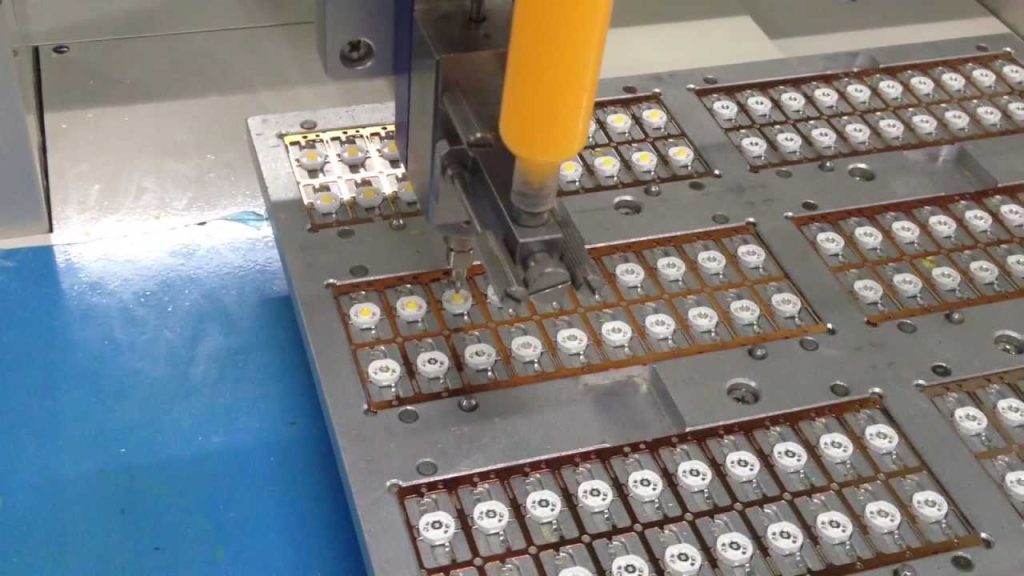
LED chips serve as the core components responsible for emitting light in LED lights. The manufacturing process of LED chips involves several intricate steps that require precision and expertise. Let’s explore the key stages involved in LED chip manufacturing:
LED chips are engineered to emit light and are critical components within various types of lighting products. The manufacturing of these chips requires rigorous precision, utilizing advanced machinery and refined techniques to ensure that each LED can create light efficiently and consistently across different applications, including flush ceiling lights and automotive headlights. The increasing emphasis on performance and energy efficiency means that today’s LED fixtures not only replace traditional incandescent light bulbs but also enhance lighting quality with features like colored lights and even light distribution. Consequently, reliable LED manufacturers prioritize innovation and quality materials to create products that illuminate spaces while maintaining durability and efficiency in the competitive bulb business.
Understanding Wafer Fabrication in LED Lights Manufacturing Process
The process begins with the fabrication of a wafer, typically made of a semiconductor material like gallium nitride (GaN). This involves the growth of a thin crystalline layer on a substrate through techniques such as metal-organic chemical vapor deposition (MOCVD). The choice of substrate and growth parameters significantly impact the performance and efficiency of the LED chips.
The proper fabrication of a semiconductor wafer, typically composed of gallium nitride (GaN), is crucial for the quality of light-emitting diodes (LEDs) used in various applications, including brake lights and automobile headlights. Advanced manufacturing techniques and machinery enable the production of LEDs that emit light efficiently, thereby improving the reliability and energy efficiency of lighting fixtures in today’s market. By focusing on these aspects, a local manufacturer can ensure that the LED features meet the growing demands of both commercial and residential lighting solutions.
Epitaxy Process: Understanding the Key Steps in LED Lights Manufacturing
During epitaxy, additional layers are grown on the wafer to create the active region where light emission occurs. This is achieved through epitaxial deposition methods, such as molecular beam epitaxy (MBE) or metal-organic vapor phase epitaxy (MOVPE). The epitaxial layers consist of different semiconductor materials, including n-type and p-type layers that form a junction for efficient electron-hole recombination.
In the process of producing light-emitting diodes (LEDs), careful consideration is given to the epitaxy phase, where precise layers are added to the semiconductor wafer to enhance the light-generating properties. This meticulous process not only involves selecting suitable electrical materials for the active region but also emphasizes the need for advanced optical transmission techniques to ensure that the resulting LED fixtures deliver reliable and evenly-distributed lighting. Consequently, the commitment of a perfect manufacturer to innovation and quality shines through as they create functional products tailored for both traditional light bulbs and modern applications.
Dicing & Packaging: Key Steps in LED Manufacturing Process
After the epitaxy process, the wafer is diced into individual LED chips. Precision cutting techniques, such as laser scribing or mechanical sawing, are employed to separate the chips while minimizing waste. Once diced, the LED chips undergo a packaging process to protect them and facilitate electrical connections. This includes attaching electrical contacts, such as gold or aluminum wire bonds, to the appropriate regions of the LED chip.
The careful separation of LED chips after the epitaxy process is vital in ensuring minimal waste while maximizing efficiency. Each LED chip is then packaged effectively, incorporating advanced techniques to ensure robust electrical connections and superior light performance for various applications, including pendant lights and indicator lights. Reliable LED manufacturers understand that today’s successful LEDs must not only replace traditional incandescent light bulbs but also enhance energy efficiency and lighting quality, addressing the diverse needs of the LED market. The use of modern technologies in the manufacturing facility allows for the continual improvement of LED fixtures, ensuring they can provide consistent illumination across a range of environments, from flush ceiling lights to specialized lighting solutions.
LED Light Assembly: Understanding the Key Steps in the Manufacturing Process
The assembly of LED lights involves bringing together various components to create a fully functional lighting device. This process requires meticulous attention to detail and careful execution to ensure optimal performance, reliability, and aesthetics. Let’s explore the key steps involved in the assembly of LED lights:
In the assembly of LED lights, each component is meticulously placed and connected to ensure that the final product not only meets aesthetic standards but also functions effectively. The careful integration of lights and fixtures during this phase is critical, as it lays the groundwork for the efficiency and performance of the LED fixtures in practical applications. Reliable lighting supply solutions emphasize the need for proper setup and the use of modern technologies, ensuring that the assembled LEDs create light consistently and efficiently. Ultimately, the collaboration of various elements results in successful LEDs that cater to diverse needs, from traditional incandescent lightbulbs to innovative lighting designs like colored lights and pendant lights.
PCB (Printed Circuit Board) Manufacturing Process in LED Lights Production
The assembly process begins with the fabrication of the PCB, which serves as the foundation for mounting and connecting the LED chips and other electronic components. The PCB is typically made of non-conductive material like fiberglass or ceramic, with copper traces etched onto it to provide electrical pathways.
The next step in the assembly involves ensuring that all components are aligned correctly on the PCB before soldering them into place. This meticulous process is integral to the overall efficiency of the manufacturing line, as any misalignment can lead to failures in the LED function and uneven lighting distribution in the resulting products. Moreover, optimizing this setup not only enhances the quality of the products but also reinforces the importance of using modern technologies to achieve successful LEDs that consistently emit the desired light color and brightness.
SMT Assembly Process: Understanding LED Lights Manufacturing
Surface Mount Technology is commonly used in LED light assembly, allowing for the precise placement and soldering of components onto the PCB. Automated equipment is utilized to accurately position and solder surface-mount LED chips, resistors, capacitors, and other electronic components onto the PCB. This process ensures secure electrical connections and efficient use of space on the board.
Surface Mount Technology is commonly used in LED light assembly, allowing for the precise placement and soldering of components onto the PCB. Automated equipment is utilized to accurately position and solder surface-mount LED chips, resistors, capacitors, and other electronic components onto the PCB. This process ensures secure electrical connections and efficient use of space on the board. The emergence of modern technologies has significantly enhanced the capabilities of lighting supply solutions, enabling the production of more efficient and reliable LEDs today. As a result, successful LEDs now offer a broader spectrum, including colored lights and white light LEDs, tailored for various applications from pendant lights to flush ceiling lights.
Soldering & Connecting Components: Understanding the Process Behind LED Lights
Soldering plays a crucial role in securely connecting the LED chips, electrical contacts, and other components to the PCB. This is typically done using reflow soldering techniques, where solder paste is applied to the PCB, and the entire assembly is heated to melt the solder and create reliable connections.
Soldering is a critical procedure in the manufacturing line of LED products, ensuring solid connections between LED chips and other electronic components. In this age of advanced manufacturing technology, it is essential for the successful LEDs produced to not only deliver reliable performance but also address the diverse lighting needs of applications ranging from residential light fixtures to specialized indicator lights.
Current-Heading: Understanding Optical Components and Lens Installation in LED Manufacturing
To control and distribute the emitted light, optical components and lenses are integrated into the LED light assembly. These components help shape the light beam, enhance efficiency, and achieve desired lighting characteristics. Lenses may be added to focus or diffuse the light, depending on the specific application requirements.
Also read: How to Stop Dimmable LED Flash and Flickering
The integration of optical components and lenses into LED light assemblies is vital for controlling the distribution and characteristics of emitted light. By fine-tuning these elements, manufacturers can enhance the efficiency and performance of the final products, ensuring that LED fixtures meet varying application requirements. Moreover, achieving specific brightness levels and minimizing the risk of uneven lighting portrays how crucial a careful design and assembly process is for reliable LED lights. The combination of modern technologies and high-quality materials enables today’s light manufacturers to create effective solutions that outperform traditional incandescent lightbulbs while offering a variety of options like colored lights and white light LEDs.
Quality Control and Testing in LED Lights Manufacturing Process
One crucial aspect of quality control and testing is electrical performance evaluation. This involves conducting tests to assess the forward voltage, current-voltage characteristics, and electrical continuity of the LED lights.
In addition to electrical testing, light output, and color quality are also assessed. Luminous intensity, color temperature, and color rendering index (CRI) are measured to determine the brightness and color accuracy of the LED lights. This step ensures that the lights meet the desired specifications and provide consistent and visually appealing illumination.
Quality control and testing for LED lights are not limited to the manufacturing phase alone. Random sample testing and inspections may also be conducted during the post-production stage to verify the ongoing quality and consistency of the LED lights.
Quality control and testing are essential for ensuring the reliability and performance of LEDs (light-emitting diodes). By meticulously evaluating the electrical performance and light output, manufacturers can verify that their lights consist of high-quality components that align with market standards, especially in terms of color accuracy and brightness. To achieve high performance, the manufacturing process must integrate modern technologies that enhance the production flow efficiency of led lights and fixtures. Furthermore, for manufacturers, understanding how to create colored lights that maintain light consistency is vital for maintaining a competitive edge in the bulb business.
Exploring Environmental Considerations in LED Lights Manufacturing Process

LED manufacturers take into account various environmental considerations throughout the manufacturing process to minimize their ecological footprint and promote sustainability. Let’s explore some of these key environmental considerations:
- LED lights are renowned for their energy efficiency, consuming significantly less electricity than traditional incandescent or fluorescent lights. By manufacturing LED lights that require lower power consumption, manufacturers contribute to reducing greenhouse gas emissions and decreasing the overall demand for electricity.
- LED lights are designed to be free from hazardous substances like mercury, which are commonly found in traditional lighting technologies. LED manufacturers adhere to regulations and guidelines such as RoHS (Restriction of Hazardous Substances) to ensure the absence of harmful materials in their products. This reduces the environmental impact during production, usage, and end-of-life disposal.
- LED lights have a longer lifespan compared to traditional lights, resulting in reduced waste generation and fewer replacements. Manufacturers focus on producing LED lights with high-quality components and robust designs to enhance durability and minimize the need for frequent replacements, thereby reducing waste and resource consumption.
- LED manufacturers encourage the proper recycling and disposal of LED lights at the end of their lifespan. LEDs can contain valuable materials such as aluminum, copper, and rare earth elements that can be extracted and reused. Proper recycling practices help minimize environmental pollution and conserve valuable resources.
- LED manufacturers strive to implement sustainable manufacturing practices. This includes optimizing energy usage in production facilities, minimizing water consumption, reducing waste generation, and promoting the use of eco-friendly materials and packaging.
You may also like: Should You Switch From CFL To LED Light Bulb?
Environmental considerations in LED lights manufacturing encompass the efficient use of electricity and materials to ensure minimal waste and reduced ecological impact. As reliable light manufacturers strive for sustainability, they focus on producing effective LED fixtures that not only enhance energy efficiency but also contribute to lower carbon emissions compared to traditional incandescent light bulbs. Through careful design and advanced manufacturing techniques, these modern LEDs create light that meets various application needs while aligning with sustainable practices in the lighting supply industry. Ultimately, the integration of new technology ensures that lights consist of the highest quality components, making them a perfect bulb choice for consumers prioritizing eco-friendly solutions.
Final Thoughts on LED Lights Manufacturing Process: Key Components and Considerations
In conclusion, the manufacturing process of LED lights is intricate and requires a sophisticated blend of technology, precision engineering, and quality control to ensure that the final products meet the necessary standards of efficiency and durability. Starting with the creation of the LED itself, the process involves semiconductor wafer fabrication where layers of materials such as gallium arsenide or gallium nitride are deposited. These materials are critical because they determine the color and efficiency of the LED. The wafers are then cut into very small pieces, each becoming an individual LED. This step is followed by the mounting of these diodes on heat sinks to manage heat dissipation, a vital aspect since overheating can significantly reduce the lifespan and performance of LEDs.
Furthermore, the assembly process involves soldering these diodes onto printed circuit boards (PCBs) and integrating them with other electronic components like resistors and capacitors that help regulate the power flow. Each unit then undergoes rigorous testing to check for electrical functionality, color consistency, and luminosity. Quality control at every stage of assembly ensures that any defects are identified and rectified early in the production process. Finally, the LEDs are encased in durable, light-enhancing lenses and assembled into their final housing, which varies depending on their intended use — from industrial lighting fixtures to residential light bulbs. The ability to efficiently scale these processes while maintaining high standards of quality is crucial for LED manufacturers to meet the growing global demand for these energy-efficient lighting solutions. This manufacturing complexity reflects the sophistication of LED technology, which is continually advancing to provide brighter, more durable, and increasingly efficient lighting options.
So, the next time you switch on an LED light and enjoy its efficient and vibrant illumination, remember the journey it has taken from the research labs to the assembly lines, embodying the ingenuity of human innovation and the commitment to a brighter, greener future.




